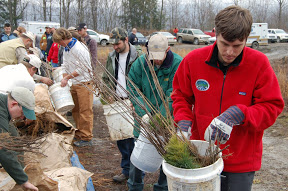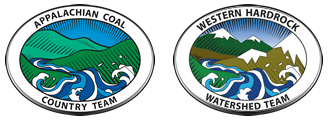The Office of Wetlands, Oceans and Watersheds (OWOW) is one of four program offices in the Office of Water (OW) at the Environmental Protection Agency’s (EPA) headquarters in Washington, DC. OWOW shares responsibility for safeguarding the nation’s water resources with three other OW offices, EPA’s 10 regional offices, and the states, tribes, and territories that implement many aspects of their water programs. Sister OW offices include the Office of Science and Technology, the Office of Wastewater Management, and the Office of Ground Water and Drinking Water. Together with OWOW, these offices implement key components of the nation’s core clean water programs. To learn more about EPA’s Office of Water, visit www.epa.gov/ow.
The Office of Surface Mining Reclamation and Enforcement (OSM) is a bureau within the United States Department of the Interior. OSM is organized with Headquarters located in Washington, DC, and three regional offices – the Appalachian, Mid-Continent, and Western regional offices. The Bureau was created in 1977 when Congress enacted the Surface Mining Control and Reclamation Act. OSM works with State and Indian Tribes to assure that citizens and the environment are protected during coal mining and that the land is restored to beneficial use when mining is finished. OSM and its partners are also responsible for reclaiming and restoring lands and water degraded by mining operations before 1977. For more information about OSM, visit www.osmre.gov.
AmeriCorps VISTA is the national service program designed specifically to fight poverty. Founded as Volunteers in Service to America in 1965 and incorporated into the AmeriCorps network of programs in 1993, VISTA has been on the front lines in the fight against poverty in America for more than 40 years. VISTA members commit to serve full-time for a year at a nonprofit organization or local government agency, working to fight illiteracy, improve health services, create businesses, strengthen community groups, and much more. For more information, visit www.americorps.gov.

ACKNOWLEDGEMENTS
Special thanks to all of the people who contributed to the development of this Toolkit:
OSM/VISTA Teams
April Trent, Megan Acord, Elizabeth Dues, Stephanie Lilly, Monica Freeland, Caitlin Coleman, Cora McCold, Rachel Folk, Scott Fanello, Lauren Lindgren, Kat Bawden, Shannon Philbin, Nate Johnson, Alaina Asbury, Andrew Barnes, Amber Heft, Adrian Uzunian, Alex Brooks, Rachel Yoke, Spencer Moss, Katie Coulter, Elizabeth Lindner, Joel Hager, Elise Rodgers, Justin Theal, Emily Kostyo, Troy Burbank, Jonathan Stewart, Katie Commender, Virginia Farley, Alexandre Genest, Jorie Emory, Genevieve Moran
Environmental Protection Agency’s Office of Wetlands, Oceans, and Watersheds
Bonnie Thie
Katie Flahive
Don Waye
Office of Surface Mining Reclamation and Enforcement
Alfred Whitehouse, Chief, Division of Reclamation Support
Citizen’s Conservation Corps of West Virginia
Other Partners
Heather Lukacs, M.Eng., Stanford University Doctoral Candidate
Dr. Tom Koontz, Professor of Environmental Policy in the School of Environment and Natural Resources at The Ohio State University
Dr. Jeff Brudney, Albert A. Levin Chair of Urban Studies & Public Service at Cleveland State University
Mark Hager, Associate Professor of Nonprofit Studies in the School of Community Resources & Development at Arizona State University
The hardworking organizations of the Appalachian Coal Country Team and Western Hardrock Watershed Team, especially:
Plateau Action Network, Fayetteville, WV
Redbank Watershed Association, New Bethlehem, PA
Upper Guyandotte Watershed Association, Mullens, WV
George’s Creek Watershed Association, Barton, MD
Headwaters, Inc, Whitesburg, KY
McClure River Restoration Project, Clintwood, VA
Morris Creek Watershed Association, Montgomery, WV
Woodland Community Land Trust, Clairfield, TN
North Fork River Improvement Association, Hotchkiss, CO
Lake Fork Valley Conservancy, Lake City, CO
Friends of Deckers Creek, Morgantown, WV
Schuylkill Headwaters Association, Pottsville, PA
Little Beaver Creek Land Foundation, Lisbon, OH
Crooked Creek Watershed Association, Indiana, PA
Friends of Russell Fork, Haysi, VA
Lackawanna River Corridor Association, Scranton, PA
Upper Pecos Watershed Association, Pecos, NM
Friends of the Cheat, Kingwood, WV
Shamokin Creek Restoration Alliance, Shamokin, PA
Rural Appalachian Improvement League, Mullens, WV
Piney Creek Watershed Association, Beckley, WV
Brownsville Area Revitalization Corporation, Brownsville, PA
Friends of Milam Creek, McGraws, WV
Coal Creek Watershed Coalition, Crested Butte, CO
Savage River Watershed Association, Frostburg, MD
Lackawanna Heritage Valley Authority, Scranton, PA
Kids’ Pasta Project, Hotchkiss, CO
Kiskiminetas Watershed Association, Leechburg, PA
Upper South Platte Watershed Association, Lakewood, CO
Mountain Studies Institute, Durango, CO
Upper Tennessee River Roundtable, Abingdon, VA
Friends of Lower Muskingum River, Marietta, OH
Roaring Run Watershed Association, Apollo, PA
Clear Fork Watershed Council, Mt. Vernon, KY/Jellico, TN
Edited by Joy Bolen
